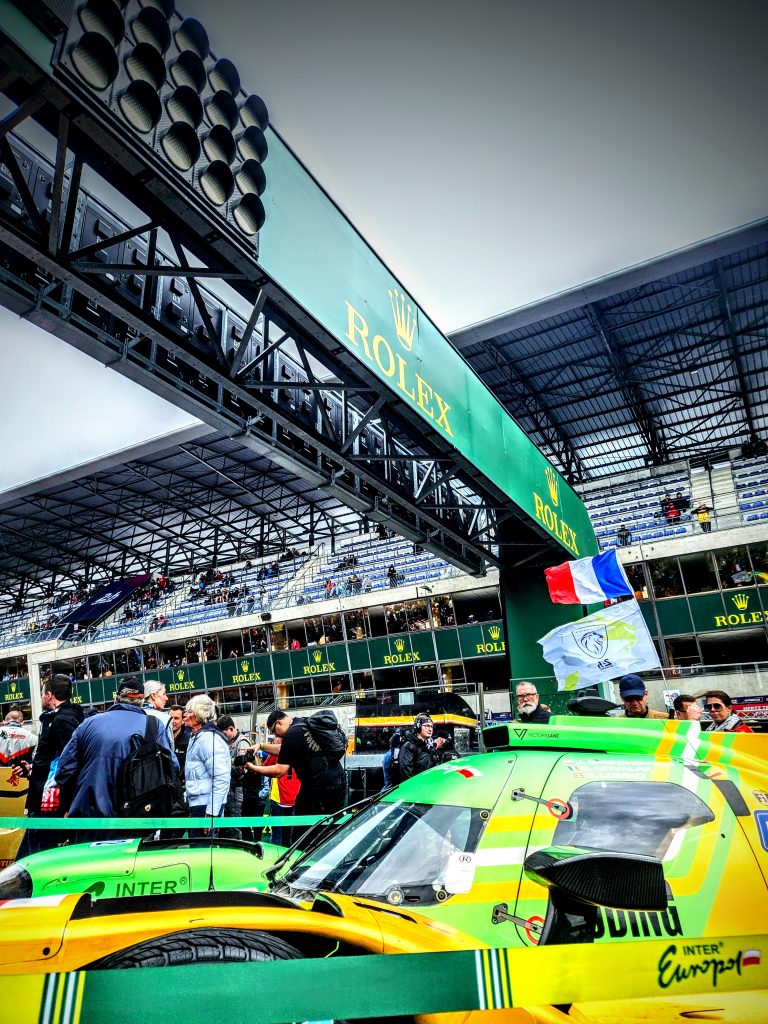The Role of the Great Race
For over a century the 24 Hours of Le Mans has been the center of the sports car racing universe. While it is nominally just round four of eight in the 2024 World Endurance Championship (WEC) it is by far the most important in terms of points and prestige.
Those familiar with forms of motor racing such as F1, NASCAR, or IndyCar, will find sports car racing to be a completely different endeavor in terms of length, the number of drivers and the conduct of the competition. Most races run to time rather than a set number of laps. WEC races range from 6 to 24 hours. There are multiple drivers per car, a team of three being the standard at Le Mans.
While there is no clear definition of “sports car”, the underlying philosophy is that they have some vestigial connection to high performance roadworthy machines. This spiritual link is kept in place by requiring them to be full-bodied and to maintain a location for a theoretical passenger seat. Unlike other forms of racing, most sports car races feature several different classes. A given class comprises cars with comparable performance characteristics and while the overall winner garners the most attention, there are awards given to each of the class winners as well. There are two broad categories of sports cars, Prototypes and GTs (Grand Touring). The former are not prototypes in the industrial sense of the word, i.e., presaging production, but rather are pure thoroughbred sports cars built purely for racing. GT, on the other hand, are racing versions of production cars found in the showroom.
There are two classes of Prototypes at Le Mans, Hypercar and P2 (Prototype 2). Hypercar represents the apogee of sports car tech. Power output and minimum weight are regulated but beyond that designers have relatively free reign. The engine size and architecture and most aerodynamic features are open to interpretation. Electric motor-internal combustion engine hybrids are now used on all the Hypercars. Some deliver the electric power to all four wheels, others only to the rear. The difference is based on slight rules variations as to whether a car is built to Le Mans specs or those used in the North American series, IMSA.
P2 is a far more restricted class. The 4.2 litre 440 bhp V8 built by Gibson Tech is mandated. While there are several chassis manufacturers to choose from, in practice all of the recent entries have been built by the French specialist, Oreca. P2 is home to an important mainstay of Le Mans through the years, the well-appointed enthusiast.
This will be the first year for GT3 representing Grand Touring at Le Mans. GT3 offers slightly less performance than did the GTE (GT Endurance) class of previous years. However, GT3 is more of a global standard and results in there being a greater variety of brands present. GT3 rules incorporate the concept of balance of performance (BOP) which governs power output, fuel flow, weight, and aerodynamics in insuring that no single manufacturer exerts undue dominance.
The 186 drivers expected to start this year are divided into four “precious metals” groups; platinum, gold, silver, and bronze. The most highly ranked, similar to those found in F1, are platinum. Gold connotes professional full-time drivers. Silver includes pros who are on the ascent or are not full-time, highly accomplished amateurs, and drivers previously ranked gold who have ‘aged’ out. Bronze are predominantly the amateur cohort. The term (as used here) does not imply lower skill level, but rather the classic sense of the amateur being a person who engages in an endeavor for passion and not for livelihood. The driver classifications are important insofar as there are minimum and maximum time limits for stint times according to ranking.
The 2024 Edition
The entry list includes 23 Hypercars divided amongst eight manufacturers. Whilst all are represented by factory associated teams, Porsche has notably begun to expand by offering cars to private teams and the Hertz Team Jota Porsche 963 enjoyed the first victory by a customer effort in the Hypercar era at the most recent round, Spa-Francorchamps. Le Mans is tough climb from there but look for a good intra-brand fight between them and the very formidable Porsche factory team overseen by one of the all-time greats in all motor sport, Roger Penske.
Defending champions Ferrari AF Corse have proven fast but fragile this season so everyone will cast a wary eye as to whether they have solved their issues. Perennial champions Toyota may be nearing the end of the development cycle on their current model but will be looking for a defiant last hurrah. The BMW has yet to emerge on top but is looking for a breakthrough. The two French manufacturers, Peugeot and Alpine have been chasing issues with their new 2024 models. Lamborghini is still at an early state of development while the revival of an ancient marque name, Isotta-Fraschini, adds a hint of Italian spice.
Most of the Hypercar (and GT3) entries are WEC regulars but there are invitees from other series. In the Hypercar class this comes from the IMSA based Cadillacs and an expanded Porsche effort. The Chip Ganassi run Cadillac V-Series R has been very successful in North America and may be poised to transfer that to Europe.
There also 23 starters in GT3. They are customer teams representing nine manufacturers. Porsche, Aston Martin, BMW, and Lamborghini have all recorded podium spots in the three rounds thus far this season. BMW, Lamborghini, along with McLaren were all absent during the GTE era but each have been successful in global GT3 racing and it remains to be seen whether they can transfer that formula to the WEC. Thus far the Belgian based WRT team BMWs and the two separate Manthey Racing run Porsche operations have the best start.
Among the non-WEC regulars in GT3 are several additional Ferraris. That gives the 296 GT3 a numerical boost to match Porsche. French team ASP is debuting Lexus to Le Mans, the marque having done well in IMSA. There is much excitement about the two American GTs, the Corvette and the Mustang. Both models are new to GT3, and the TF Sport entry is particularly noteworthy as it is the first time in decades that a privateer Corvette is on the scene. The GT3 class has a particularly rich mixture of teams and drivers that have done well in other series. One of those is the Michelin Le Mans Cup which is part of the support schedule this weekend. Winners and champions from the Road to Le Mans races will be invited to the 24 Hours in 2025.
The P2 class is not contested in other WEC rounds but is a major part of the North American, European, and Asian regional series. The entries emanate from those sources. They may all be spec Oreca-Gibsons, but the inter-team competition among the 16 teams is fierce. Nine of the cars also compete in a subsidiary class for Pro-Am awards. Nearly all of the teams have tasted some form of success in the past 18 months. Jumping into the WEC fray for all will be a challenge and team and driver preparedness will be the key.
Crowdstrike Racing by APR may be a favourite, coming off being Asian champion and 2023 runner-up in IMSA. Their sister team, Algarve Pro Racing, is a powerhouse at Le Mans. Other key teams in the class are Cool Racing, Inter Europol Competition, and AF Corse. United Autosports is a bit of dark horse, having been dominant in the past but stumbled of late.
A Primer to Following Le Mans
Those who may have followed Le Mans in the past and are returning in 2024 would find one facet the most surprising. And no, it is not technical advancement. While that is significant, especially in Hypercar, such progress is the natural order. Most astonishing is the reliability of the field. For the past decade well over 70% of the starters have still been circulating on Sunday afternoon. Last year, attrition was anomalously high – but the finishing rate was still better than that found through most of the 1990s and especially the 1980s. Moreover, the margins of victory and the gaps between all the top finishers in each class has dramatically shrunk. It has become more of a 24-hour sprint rather than an endurance test. In the “good old days” even the winner could be expected to make at least one lengthy stop and still maintain a multi-lap margin. Today, multiple cars on the lead lap to the very end are commonplace. This has altered the strategy within the race – and has turned following the event from tedium into a dramatic cliff-hanger.
The long series of test, practice, and qualifying sessions before the race may at first glance appear superfluous, but keen observation helps reveal which teams are well prepared. Some cars may coast through to the grid with few issues. Others encounter problems but then iron them out, whilst there is concern if a car spends undue time in the pits and then doesn’t markedly improve their track performance. It is helpful to spot check the lap times of the three different drivers on the roster. Are the margins between the fastest and slowest narrow? If not, they may strain both the skills and allotted time of the quicker members.
Practice and qualifying offer opportunities to observe garage and paddock operations. Does the crew descend on the car in a well-managed choreographed analog to a hospital operating theater, or is it a mad slapstick dash to find tools and argue over the issues? The old adage “an army marches on its stomach” applies here. Are the crew well catered for? Do they enjoy ample breaks – plus nutritious meals and snacks? Are the drivers (and frequently crew) attended to by physio care and consultation? The winners always score high on these criteria. Overall, is there good communication between managers, engineers, strategists, pit crew, and the drivers? While much of this is behind the scenes, it becomes as enjoyable as watching film noir to look for subtle clues.
As the contest unfolds, reassess the observations from the pre-race period. The opening hours will inevitably feature a taut fight to see which teams emerge as the “rabbit.” The first stops begin to reveal each team’s unique strategy. Are they double stinting their fastest drivers or are they opting to hold back? Somewhere around evening time the initial patterns will become apparent. Through to the morning there will be a fight to gain incremental advantage, often by trying to outwit opponents over the pit stop patterns and tyre changes. The obvious principal objective being to minimize the time that the car is stationary. Above all, stay out of trouble. With technical failure becoming less common, most retirements now emanate from damage. The circuit and its rules are unforgiving. The long Le Mans lap means that a miscalculation on fuel or damage early on jeopardizes the driver’s ability to bring the car home. A stranded car is deemed abandoned and may not return to the race.
Enjoy witnessing another chapter of drama being added to the lore of Le Mans. From the technical wonders of the Hypercar, to the colourful array of brands and liveries, to the tense nature of the close racing, we are truly enjoying a Golden Age of Sports Car Racing.
By Janos Wimpffen















